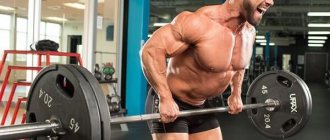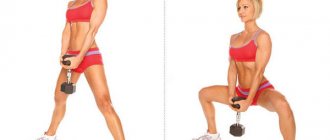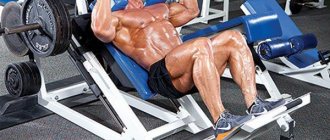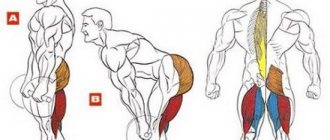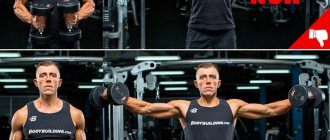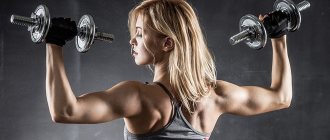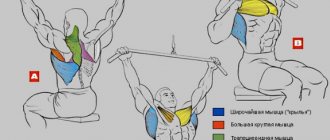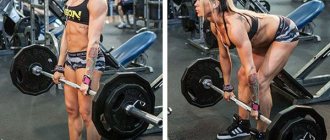Publication date: December 24, 2021.
Sumo squats are squats with a wide stance and toes turned outwards, which allow you to load the muscles of the buttocks and inner thighs.
They are very similar to plie squats. Many people do not distinguish between these two exercises at all.
We will consider sumo squats to be squats in which the legs are located at the maximum distance from each other, and the toes point forward and to the sides.
Accordingly, plie squats are an exercise that involves a less wide stance of the legs.
Execution options
This exercise can be performed with a dumbbell, kettlebell or barbell. The dumbbell is held at chest level or in your arms down.
You can do the same with a weight, but this projectile is more suitable for holding it down. The barbell can be placed on your shoulders or also lowered down.
Sumo squats can be done without any weights at all. This option is suitable for beginners who are just mastering the technique of performing the exercise or simply cannot do it with dumbbells, a kettlebell or a barbell. It can be difficult for them to maintain balance when performing sumo squats.
Benefits of plie squats (sumo)
Squats (plie) are used to warm up and strengthen the core muscles of the lower extremities. With multiple repetitions, they make the muscles more resilient and stronger. But that is not all. Sumo squats increase the functionality of the leg joints and make the ligaments and tendons more elastic. The Achilles tendon is actively stretched, in the area of which a so-called “heel spur” can form with age. Plie serves as a preventative measure for this very unpleasant disease.
Plie squats help you quickly and effectively form beautiful legs and firm, pumped buttocks. Proven effectiveness and simplicity have made the exercise incredibly popular. It is performed in the gym, as part of fitness training and at home.

Sumo or plie squats are the best exercise for the legs and buttocks
And of course, like any other types of squats, sumo helps to increase the speed of metabolic processes, energy consumption, and burn fat deposits. Therefore, they are often included in training complexes aimed at weight loss.
Execution technique
- Stand in the starting position: your legs should be located twice as wide as your shoulders or even further apart, the selected weight should be in your arms down, at chest level or on your shoulders, your gaze is directed straight, your back is straight.
- As you inhale, slowly lower yourself forward.
- Exhale and quickly stand up, returning to the starting position.
Don't forget about the warm-up approach: before you start working with a working weight, do a series of squats without load or with minimal weight.
Warm-up sets, along with a five to ten minute warm-up at the beginning of your workout, allow you to avoid injury and perform all exercises at maximum efficiency.
The better the stretch in your legs, the easier it will be for you to complete the exercise. Thanks to well-stretched muscles, you will be able to place your feet at the maximum distance from each other.
Make sure that your feet are positioned strictly on the same line, and the angle of your toes is also the same. If your feet are not mirrored, the load on the left and right halves will also be asymmetrical.
If you perform the exercise with incorrect leg positioning for a certain time, this will lead to asymmetrical development of the right and left legs.
Also make sure your knees point in the same direction as your toes. However, they should not sway from side to side during the exercise.
During the negative phase of the movement, move your pelvis back. Many people do this exercise incorrectly, leaving their buttocks essentially at the same level throughout the entire set instead of moving them back and forth.
This should not be done; incorrect technique reduces the effectiveness of working the target muscles and increases the likelihood of injury.
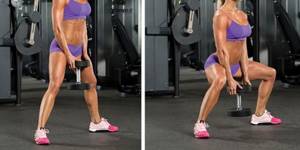
Common Mistakes
- Do not round your back; you should keep it straight throughout the entire approach. Make sure your shoulders are straight and there is a slight arch in your lower back. It will be easier to maintain the correct position of the body if you direct your gaze straight ahead, you can even raise your eyes higher, forward and up.
- Do not bring your knees forward beyond your toes - this is the golden rule of exercise, which also applies in this exercise. In order to achieve this, you simply need to move your pelvis back while performing a squat.
- Don't carry too much weight. Despite the fact that to increase muscle size you need to work with maximum weights, it is important not to overdo it. If you cannot do a squat with the correct technique with the selected weight, its weight must be reduced.
Types of squats
These variations are performed to work the muscles more deeply, or to work on the weak points of the power movement in powerlifting.
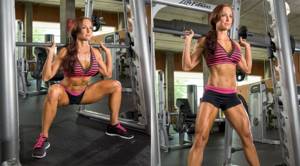
Simulates a stance in a sumo deadlift. Develops hips, buttocks and hip adductors.

The barbell is held on the chest, a clear approach is required. The body cannot tilt forward.
Zerchera
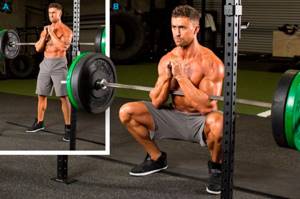
The barbell is held by bending the elbow, at waist level. The movement serves to correct excessive forward lean in the classic barbell squat.
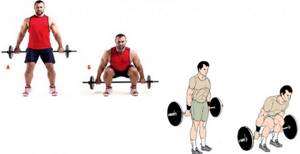
The barbell is grasped with a straight grip behind the back. Some believe that this works the hamstrings and buttocks better.
Lunge Squat
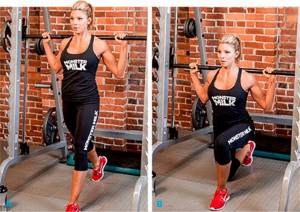
One of the scissoring movements that corrects leg imbalances is essentially one foot placed slightly back on the toes and the athlete simply lowers into a squat from that position.
One leg squat
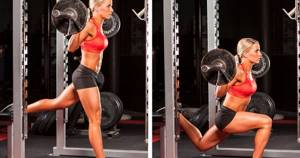
The athlete stands on the box, stretches forward or simply lowers the non-supporting leg and performs the movement first with one leg, then with the other. This is necessary to correct the “difference in strength” of the legs.
Interesting Facts
As you might guess, this exercise got its name due to the fact that the pose of the athlete performing it is similar to the stance of a sumo wrestler in the arena.
Despite the fact that sumo wrestlers look very clumsy, they are in good physical shape - the norm for them is several hours of grueling training a day. Among other things, they do stretching and strength training.
By the way, sumo wrestlers also do those same squats that we call sumo squats. Traditionally they are performed with a large stone held at chest level.
Thanks to regular exercises to stretch muscles and ligaments, those who engage in this unique sport can squat very low. All athletes should take note of this point: good stretching is never too much.
Pancakes under the heels
You probably paid attention to some super mega online trainers and part-time fitness bikini trainers - how they place small discs (“pancakes”) weighing up to 1.25-2.5 kg under the heels before squats. Beginners often copy such habits of their more “wise and sophisticated” owners of gorgeous asses, without even asking themselves why this is necessary
It is believed that this is better, just better, without details.
“The exercise is more effective, it seems that the gluteal muscles feel better, but I don’t know…”
It seems very similar to the opinion that small, frequent meals speed up metabolism. If you still believe in this, you are welcome: “Dear, I accelerated my metabolism or myths about “promoted” metabolism”
In fact, there is a logical explanation for such actions. Even two at once: a higher heel position is needed either to isolate the quadriceps (quadriceps muscles of the thigh), or to neutralize the lack of stretch development.
In the first case, simultaneously with the lining of the discs, the width of the stance changes: the legs are placed narrower, the toes point straight forward or at a slight angle to the sides (less than 45 degrees). The technique of squats is also changing: they are moving away from deep squats to half-squats. The grip width of the barbell with your hands increases, up to extreme marks, and the pace slows down to medium or even slow. The back is held vertically, and the bar is held somewhere at the level of the spine of the scapula or even higher. All this allows you to isolate the quadriceps femoris muscle.
In the second case, pancakes are placed under the heels to compensate for insufficient stretch development. You need to understand that this is a necessary measure, and you need to correct your physical imperfections: develop and improve your stretching.
WHAT ARE THE DANGEROUS OF PANCAKES UNDER THE HEELS:
If your heel is raised, the load on the knee joint noticeably increases, and therefore it is easy to get injured. This load leads to increased wear and tear on the knees. So adding pancakes is a short-term, dangerous and, in our opinion, rather pointless measure. And the gluteal muscle is actively and fully worked out only in the case of squats without pancakes.
Bone Wide does not recommend placing boards, plates or blocks under your heels when squatting. If you can’t do it without them, it means only one thing: you don’t have enough stretching and your inflexible muscles don’t allow your body to take the desired position. First of all, you should stretch the Achilles tendons, hamstrings, hip adductors and buttocks
In addition, you will need to pay attention to stretching the muscles of the shoulder girdle and pectoral muscles - otherwise you simply will not be able to hold the barbell in the desired position
If stretching is really difficult, take at least 6 weeks to gradually and carefully improve the stretchability of your muscles, and only then think about starting to learn the squat technique. Of course, just doing squats will help improve the stretch, but during this “learning” period you will not be able to squat with good form.
For this reason, you run the risk of “learning” a bad technique, which you then have to “unlearn”
Of course, just doing squats will help improve the stretch, but during this “learning” period you will not be able to squat with good form. For this reason, you run the risk of “learning” a bad technique, which you then have to “unlearn.”
No matter how good or bad your leverage (i.e. limb length and limb ratio) is, good stretching will help you squat more technically than any heel pads.
Adviсe
- Choose the appropriate type of apparatus - it can be a dumbbell, a kettlebell or a barbell.
- When performing a squat, move your pelvis back, do not bring your knees forward so that they protrude beyond your toes.
- Maintain a slight arch in your lower back and keep your back straight.
- To achieve rapid muscle growth, use heavy weights, but be careful: if you cannot do the exercise with the selected weight with the correct technique, reduce the load.
- If you want to achieve maximum muscle gains, do 6 to 15 repetitions per set.
Sample training program
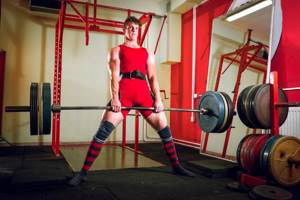
Most weight lifting exercises are included in the training process either for the purpose of gaining additional volume or to increase strength indicators. Beginners should not immediately lift heavy weights. You should start small. Even experienced lifters are also not recommended to lift the usual weight, since changing emphasis requires adaptation.
If your goal is strength, do 3 sets of 4 reps. This is due to the fact that sumo is not the only pulling exercise, so there is no particular point in striving to give it your all. If the deadlift is done last during training, then you can perform four approaches, but for the final one, take lighter weights and bring it up to twelve repetitions. This loads the muscles to capacity and allows you to completely burn all the remaining energy during the workout.
Those who want to increase muscle size, but not increase strength, should do from eight to twelve repetitions. When the maximum number of repetitions is given without any difficulty, then the weight lifted should be increased. In this case, the number of repetitions is reduced to nine to ten. You need to do three approaches. The sumo deadlift brings maximum benefit only when, after the last repetition, you no longer have the strength to lift the apparatus again. Otherwise, either the weights are too light or the number of repetitions needs to be increased.


